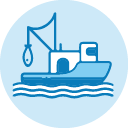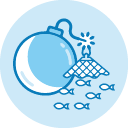
Text
Abandoned, lost or otherwise discarded fishing gear
Abandoned, lost or otherwise discarded fishing gear (ALDFG) is a problem that is increasingly of concern. Various United Nations General Assembly resolutions now provide a mandate for, and indeed require, action to reduce ALDFG and marine debris in general. Consequently, the United Nations Environment Programme (UNEP) and the Food and Agriculture Organization of the United Nations (FAO) entered into an agreement to carry out a study in relation to ALDFG in order to raise awareness of the extent of the problem and to recommend action to mitigate the problem of ALDFG by flag states, regional fisheries management bodies and organizations, and international organizations, such as UNEP, the International Maritime Organization (IMO) and FAO. This report reviews the magnitude and composition of ALDFG, and while noting that information is not comprehensive and does not allow for any global estimates, suggests that gillnets and fishing traps/pots may be the most common type of ALDFG, although netting fragments may also be common in some locations. The impacts of ALDFG are also considered and include: continued catching of target and non-target species (such as turtles, seabirds and marine mammals); alterations to the benthic environment; navigational hazards; beach debris/litter; introduction of synthetic material into the marine food web; introduction of alien species transported by ALDFG; and a variety of costs related to clean-up operations and impacts on business activities. In general, gillnets and pots/traps are most likely to "ghost fish" while other gear, such as trawls and longlines, are more likely to cause entanglement of marine organisms, including protected species, and habitat damage. The factors which cause fishing gear to be abandoned, lost or otherwise discarded are numerous and include: adverse weather; operational fishing factors including the cost of gear retrieval; gear conflicts; illegal, unregulated and unreported (IUU) fishing; vandalism/theft; and access to and cost and availability of shoreside collection facilities. Weather, operational fishing factors and gear conflicts are probably the most significant factors, but the causes of ALDFG accumulation are poorly documented and not well understood. A detailed understanding of why gear is abandoned, lost or discarded is needed when designing and tailoring effective measures to reduce ALDFG in particular locations. A variety of measures are currently in place to reduce ALDFG, and these are profiled in this report. They include those which are preventative or ex-ante, and those which are curative or ex-post. Evidence suggests that while both are important, much of the emphasis to date has been placed on curative measures such as gear retrieval programmes and clean-up of beach litter, while preventative measures may generally be more cost-effective in reducing ALDFG debris and its impacts. This report concludes with a number of recommendations for future action to reduce ALDFG debris, be it on a mandatory or voluntary basis. It also considers at what scale and which stakeholders (e.g. international organizations, national government, the private sector, research institutions) might be best placed to address the wide range of possible measures to reduce the amount of ALDFG debris.
Availability
| B0900331 | 639.2.081.11.004.65 MAC a | Archivelago Indonesia Marine Library - Perpustakaan Kementerian Kelautan dan Perikanan | Available |
Detail Information
- Series Title
-
-
- Call Number
-
639.2.081.11.004.65 MAC a
- Publisher
- Rome : FAO., 2009
- Collation
-
xix, 115 hlm. : il. ; 30 cm
- Language
-
Indonesia
- ISBN/ISSN
-
9799251061961
- Classification
-
639.2.081.11.004.65
- Content Type
-
-
- Media Type
-
-
- Carrier Type
-
-
- Edition
-
-
- Subject(s)
- Specific Detail Info
-
-
- Statement of Responsibility
-
-
Other version/related
No other version available
File Attachment
Comments
You must be logged in to post a comment
 Perikanan Tangkap
Perikanan Tangkap  Perikanan Budidaya
Perikanan Budidaya  Pengolahan Ikan
Pengolahan Ikan  Pulau Kecil
Pulau Kecil  Masyarakat Pesisir
Masyarakat Pesisir  Local Content
Local Content  Ekspor Perikanan
Ekspor Perikanan  Illegal Fishing
Illegal Fishing  Ilmu - Ilmu Sosial
Ilmu - Ilmu Sosial  Geografi dan Sejarah
Geografi dan Sejarah